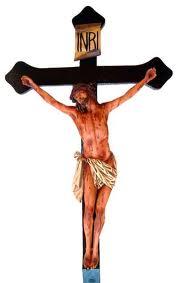A crucifix (from Latin cruci fixus meaning "(one) fixed to a cross") is a usually three-dimensional cross with a representation of Jesus' body, referred to in English as the corpus (Latin for "body"), as distinct from a cross with no body. It is a principal symbol for many groups of Christians, and one of the most common forms of the Crucifixion in the arts. It is especially important in the Roman Catholic Church, but is also used in Orthodox and Eastern Catholic, as well as Anglican, and Lutheran churches, (though less often in other Protestant churches), and it emphasizes Jesus' sacrifice — his death by crucifixion, which Christians believe brought about the redemption of mankind. Large crucifixes high across the central axis of a church, by the late Middle Ages a near-universal feature of Western churches, but now very rare, are known by the Old English term rood. Modern Roman Catholic churches often have a crucifix above the altar on the wall; for the celebration of Mass, the Roman Rite of the Catholic Church requires that, "on or close to the altar there is to be a cross with a figure of Christ crucified".
Strictly speaking, to be a crucifix the cross must be three-dimensional, and a painting of the Crucifixion of Jesus is not a crucifix. However this distinction is not always observed. While the cross must be three-dimensional, the "corpus" need not be, and in the Orthodox Church it is normally either painted on a flat surface or worked in low relief (no more than three-quarters relief).
The standard, four-pointed Latin crucifix consists of an upright post or stipes and a single crosspiece to which the sufferer's arms were nailed; but there may be a short projecting nameplate, showing the letters INRI (Greek: INBI). The Russian Orthodox crucifix usually has an additional third crossbar, to which the feet are nailed, and which is angled upward toward the penitent thief Saint Dismas (to the viewer's left) and downward toward the impenitent thief Gestas (to the viewer's right). The corpus of Eastern crucifixes is normally a two-dimensional or low relief icon that shows Jesus as already dead, his face peaceful and somber. They are rarely three-dimensional figures as in the Western tradition, although these may be found where Western influences are strong, but are more typically icons painted on a piece of wood shaped to include the double-barred cross and perhaps the edge of Christ's hips and halo, and no background. More sculptural small crucifixes in metal relief are also used in Orthodoxy, including as pectoral crosses and blessing crosses.usually three-dimensional cross with a representation of Jesus' body


